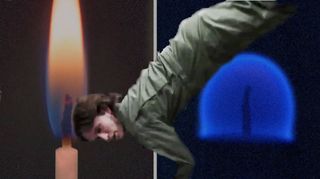Students, Teachers to Hitch Ride on NASA’s 'Vomit Comet' for Weightless Science

College students and K-12 teachers are set to take a ride on a "Vomit Comet" this week in the name of science.
As part of NASA's reduced gravity education program, seven teams of undergraduates and seven teams of classroom teachers will perform carefully designed experiments under weightless conditions during a set of parabolic flights out of Johnson Space Center in Houston.
Flying aboard a specially modified jetliner that climbs and then rapidly descends simulates the feeling of weightlessness that astronauts experience in space. This sometimes makes passengers feel ill (thus the nickname), but it also provides a rare opportunity to test the effects of microgravity without launching into orbit. [6 Everyday Things that Turn Strange in Weightlessness]
The competitively selected groups have been building their experiments over that last six to nine months to prepare for their moments in microgravity, Frank Prochaska, the program's manager, told SPACE.com. There will be four flights total from Tuesday (July 16) to Friday (July 19) and each will run through a series of 32 parabolas with 30 seconds of weightless in each.
"They'll be testing everything from the way oil and water behave in microgravity to the way light reacts in microgravity," Prochaska said.
For example, a student team from Purdue University, made up of six flyers and one ground support, will be testing how to reduce excess water in fuel cells, which could have implications for propulsion systems on Earth and in satellites orbiting the planet.
"If they have too much water on the reaction surface, the fuel cell doesn't work as well as it could," Purdue team member Patrick Griffin, an aeronautical and astronautical engineering major, told SPACE.com.
Get the Space.com Newsletter
Breaking space news, the latest updates on rocket launches, skywatching events and more!
Griffin was looking forward to experiencing weightlessness on board the flight but said he was also excited to see how other teams have organized their experiments, calling the process "a really hard thing to do in engineering."
SPACE.com Managing Editor Tariq Malik will also take a ride on the Vomit Comet this week. He will experience weightlessness with a group of students from the University of California San Diego that are testing how biofuels burn in weightless conditions.
The following is a list from NASA of the undergraduate teams set to ride the Vomit Comet this week with the names of their experiments:
- Baldwin Wallace University / John Carroll University: The Stability of Liquid Bridges under Varying Total Body Force
- Purdue University: Water Removal in Proton Exchange Membrane Fuel Cells
- Rice University Electromagnetic Position Sensing in Microgravity
- SUNY Buffalo: Microgravity Characterization of Zirconia Monolithic Electrokinetic Micropumps
- University of California San Diego: Fiber Supported Droplet Combustion of Bioethanol and Biobutanol
- University of Texas, El Paso: Combustion of Lunar and Martian Regolith Simulants with Magnesium
- West Virginia University: Optimization of Liquid Spray Cooling in a Variable Gravity Environment
And here are the teacher teams and their experiments:
- Team Kennedy, Hillsboro, MO: Absorbency of Liquids in Space
- Prior Lake-Savage Middle Schools, Prior Lake, MN: Behavior of Acoustic Energy in MicroGravity
- St. Joan of Arc School, Lisle, IL: Gravity's Affect on Magnets
- Evansville Day School, Evansville, IN: Tornado Fluid Flow in Microgravity
- Poinciana Elementary and Atlantic High School, Boynton Beach, FL: How Does Gravity Affect Convection?
- Einstein Fellows, Arlington, VA: Gravity's Impact on Coacervate Formation
- Riversink Elementary School, Crawfordville, FL: Wakulla Waters: A Liquid Investigation
Follow us @Spacedotcom, Facebook and Google+. Original article on SPACE.com.
Join our Space Forums to keep talking space on the latest missions, night sky and more! And if you have a news tip, correction or comment, let us know at: community@space.com.

Megan has been writing for Live Science and Space.com since 2012. Her interests range from archaeology to space exploration, and she has a bachelor's degree in English and art history from New York University. Megan spent two years as a reporter on the national desk at NewsCore. She has watched dinosaur auctions, witnessed rocket launches, licked ancient pottery sherds in Cyprus and flown in zero gravity on a Zero Gravity Corp. to follow students sparking weightless fires for science. Follow her on Twitter for her latest project.
